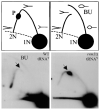Unwinding the functions of the Pif1 family helicases
- PMID: 20097624
- PMCID: PMC2853725
- DOI: 10.1016/j.dnarep.2010.01.008
Unwinding the functions of the Pif1 family helicases
Abstract
Helicases are ubiquitous enzymes found in all organisms that are necessary for all (or virtually all) aspects of nucleic acid metabolism. The Pif1 helicase family is a group of 5'-->3' directed, ATP-dependent, super family IB helicases found in nearly all eukaryotes. Here, we review the discovery, evolution, and what is currently known about these enzymes in Saccharomyces cerevisiae (ScPif1 and ScRrm3), Schizosaccharomyces pombe (SpPfh1), Trypanosoma brucei (TbPIF1, 2, 5, and 8), mice (mPif1), and humans (hPif1). Pif1 helicases variously affect telomeric, ribosomal, and mitochondrial DNA replication, as well as Okazaki fragment maturation, and in at least some cases affect these processes by using their helicase activity to disrupt stable nucleoprotein complexes. While the functions of these enzymes vary within and between organisms, it is evident that Pif1 family helicases are crucial for both nuclear and mitochondrial genome maintenance.
(c) 2010 Elsevier B.V. All rights reserved.
Figures






Similar articles
-
Eukaryotic Pif1 helicase unwinds G-quadruplex and dsDNA using a conserved wedge.Nat Commun. 2024 Jul 19;15(1):6104. doi: 10.1038/s41467-024-50575-8. Nat Commun. 2024. PMID: 39030241 Free PMC article.
-
The functions of the multi-tasking Pfh1Pif1 helicase.Curr Genet. 2017 Aug;63(4):621-626. doi: 10.1007/s00294-016-0675-2. Epub 2017 Jan 4. Curr Genet. 2017. PMID: 28054200 Free PMC article. Review.
-
Structure and function of Pif1 helicase.Biochem Soc Trans. 2017 Oct 15;45(5):1159-1171. doi: 10.1042/BST20170096. Epub 2017 Sep 12. Biochem Soc Trans. 2017. PMID: 28900015 Free PMC article. Review.
-
Yeast Genome Maintenance by the Multifunctional PIF1 DNA Helicase Family.Genes (Basel). 2020 Feb 20;11(2):224. doi: 10.3390/genes11020224. Genes (Basel). 2020. PMID: 32093266 Free PMC article. Review.
-
Branched unwinding mechanism of the Pif1 family of DNA helicases.Proc Natl Acad Sci U S A. 2019 Dec 3;116(49):24533-24541. doi: 10.1073/pnas.1915654116. Epub 2019 Nov 19. Proc Natl Acad Sci U S A. 2019. PMID: 31744872 Free PMC article.
Cited by
-
G-quadruplex and G-rich sequence stimulate Pif1p-catalyzed downstream duplex DNA unwinding through reducing waiting time at ss/dsDNA junction.Nucleic Acids Res. 2016 Sep 30;44(17):8385-94. doi: 10.1093/nar/gkw669. Epub 2016 Jul 28. Nucleic Acids Res. 2016. PMID: 27471032 Free PMC article.
-
Eukaryotic Pif1 helicase unwinds G-quadruplex and dsDNA using a conserved wedge.Nat Commun. 2024 Jul 19;15(1):6104. doi: 10.1038/s41467-024-50575-8. Nat Commun. 2024. PMID: 39030241 Free PMC article.
-
Helicase-inactivating mutations as a basis for dominant negative phenotypes.Cell Cycle. 2010 Oct 15;9(20):4080-90. doi: 10.4161/cc.9.20.13667. Cell Cycle. 2010. PMID: 20980836 Free PMC article. Review.
-
Pif1 Activity is Modulated by DNA Sequence and Structure.Biochemistry. 2022 Jan 4;61(1):10-20. doi: 10.1021/acs.biochem.1c00614. Epub 2021 Dec 21. Biochemistry. 2022. PMID: 34932305 Free PMC article.
-
The Pif1 family helicase Pfh1 facilitates telomere replication and has an RPA-dependent role during telomere lengthening.DNA Repair (Amst). 2014 Dec;24:80-86. doi: 10.1016/j.dnarep.2014.09.008. Epub 2014 Oct 7. DNA Repair (Amst). 2014. PMID: 25303777 Free PMC article.
References
-
- Schulz VP, Zakian VA. The Saccharomyces PIF1 DNA helicase inhibits telomere elongation and de novo telomere formation. Cell. 1994;76:145–155. - PubMed
-
- Ivessa AS, Zhou J-Q, Zakian VA. The Saccharomyces Pif1p DNA helicase and the highly related Rrm3p have opposite effects on replication fork progression in ribosomal DNA. Cell. 2000;100:479–489. - PubMed
Publication types
MeSH terms
Substances
Grants and funding
LinkOut - more resources
Full Text Sources
Molecular Biology Databases

